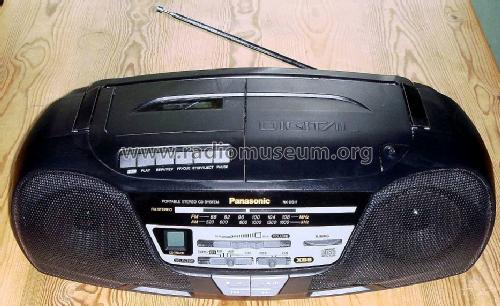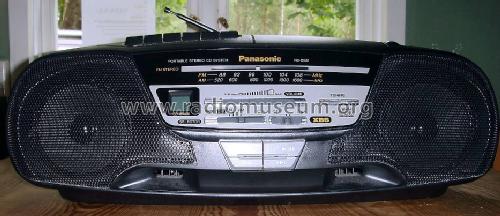RX-DS11 Digit/1L
Panasonic, Matsushita, National ナショナル (also tubes); Osaka
- País
- Japon
- Fabricante / Marca
- Panasonic, Matsushita, National ナショナル (also tubes); Osaka
- Año
- 1995 ?
- Categoría
- Radio - o Sintonizador pasado WW2
- Radiomuseum.org ID
- 118019
- Numero de transistores
- Hay semiconductores.
- Semiconductores
- Principio principal
- Superheterodino en general
- Gama de ondas
- OM y FM
- Especialidades
- Otra combinación. Ver notas.
- Tensión de funcionamiento
- Red / Baterías o pilas / 220 / 6 × 1,5 Volt
- Altavoz
- 2 Altavoces / Ø 9.5 cm = 3.7 inch
- Material
- Plástico moderno (Nunca bakelita o catalina)
- de Radiomuseum.org
- Modelo: RX-DS11 Digit/1L - Panasonic, Matsushita,
- Forma
- Portátil > 20 cm (sin la necesidad de una red)
- Ancho, altura, profundidad
- 460 x 140 x 240 mm / 18.1 x 5.5 x 9.4 inch
- Anotaciones
- The Panasonic RX-DS11 is a typical "Ghetto-Blaster-Type" Cassette AND CD-Player-AM-FM-Radio with FM-Stereo. Those "Ghetto-Blasters" have also been called Boombox, Jambox or just "radio-cassette". A boombox is capable of receiving radio stations and playing recorded music (usually cassettes or CDs), usually at relatively high volume. Many models are also capable of recording (onto cassette) from radio and (sometimes) other sources. Designed for portability, most boomboxes can be powered by batteries, as well as by line current. Early Boomboxes were not "roundly" shaped.
Wikipedia 4.Jan 2010: "Boom boxes were introduced commercially by various companies in the late 1970's, when stereo capabilities were added to existing designs of the radio-cassette recorder, which had appeared earlier that decade. More powerful and sophisticated models were subsequently introduced. They are often associated with 1980s phenomena such as breakdancing and hip hop culture, having been introduced into the mainstream consciousness through music videos, movies, television and documentaries. It was during this time that the major manufacturers competed as to who could produce the biggest, loudest, clearest-sounding, bassiest, flashiest and/or most novel boomboxes. As the decade progressed, manufacturers tended to compete more on price (often at the expense of quality), and smaller designs (often designed for simple background listening) became more popular. This era was prior to the introduction and cultural entrenchment of the Walkman style, personal stereos with headphones which would later displace boom boxes in popularity."
- Peso neto
- 1.7 kg / 3 lb 11.9 oz (3.744 lb)
- Precio durante el primer año
- 1,265.00 SEK
- Procedencia de los datos
- - - Data from my own collection
- Otros modelos
-
Donde encontrará 3130 modelos, 2914 con imágenes y 651 con esquemas.
Ir al listado general de Panasonic, Matsushita, National ナショナル (also tubes); Osaka


